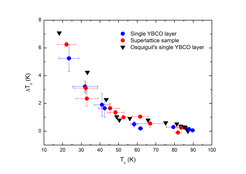Transient and Persistent Photoconductivity
Our activities in exploring transient and persistent photoconductivity (PPC) in complex oxide thin films are directed towards an external manipulation of electronic phase separation and the attempt to use photoconductivity studies as a potential tool to identify defects in the cation as well as in the anion sublattices in selected complex oxides. The latter goes back to early investigations of optically induced persistent superconductivity in oxygen deficient YBCO films (a recent review is given by Markowitsch et al.[1]). In recent experiments it has been demonstrated that, in contrast to previously published results [2], oxygen deficient YBCO-LCMO superlattices show a PPC that is mainly governed by the properties of the YBCO layers. Whereas in the previous experiments with samples sputtered at 900°C the existence of a transient photoconductivity was associated with a massive holes transfer across the interface and a fast recombination process in the LCMO layer, thus preventing the persistent effect. Our experimental results obtained with PLD grown samples at 750°C indicate that this massive hole transfer is blocked and a PPC arising in the YBCO underdoped layers (see Fig. 1). [3] These differences shed some light on the process-induced modifications of the structural and/or electronic reconstruction of the oxides interfaces.

Further experiments are performed to explore whether these PPC-effects are based on general principles or just a curiosity of underdoped YBCO. One representative example is PrNiO3-DyScO3 (PNO-DSO) superlattices. DSO is a band insulator whereas PNO is a metal with enhanced Pauli paramagnetism, converting to an antiferromagnetic insulator below 130K. We observed a drop in the resistance around 20K in several superlattices ranging from (20nm/20nm)4 to (5uc/5uc)8 after exposure to the ultra-violet (UV) light which could be interpreted as a induced photo-induced phase transition. Since neither single layer DSO nor PNO single layer films show a PPC effect or any unconventional transient photoconductivity our results are tentatively ascribed to the interface related free carrier traps such as oxygen vacancies. [4]
References
[1] Persistent photoconductivity in oxygen-deficient and ion-irradiated YBa2Cu3Ox. Markowitsch W., et al. Superconductor Science and Technology, 22, 034011 (2009).
[2] Interfacially controlled transient photoinduced superconductivity. Pena V., et al. Phys. Rev. Lett. 97, 1177005 (2006).
[3] Persistent photoconductivity in oxygen deficient YBCO/LCMO superlattices. Kawashima K., et al. in preparation (2012).
[4] Photoinduced resistivity anomalies in DyScO3/PrNiO3 superlattices. Soltan S.,et al. in preparation (2012).
[5] Photoexcitation and oxygen ordering in YBa2Cu30x films. E. Osquiguil, et al. Phys. Rev. B 49, 3675 (1994).
